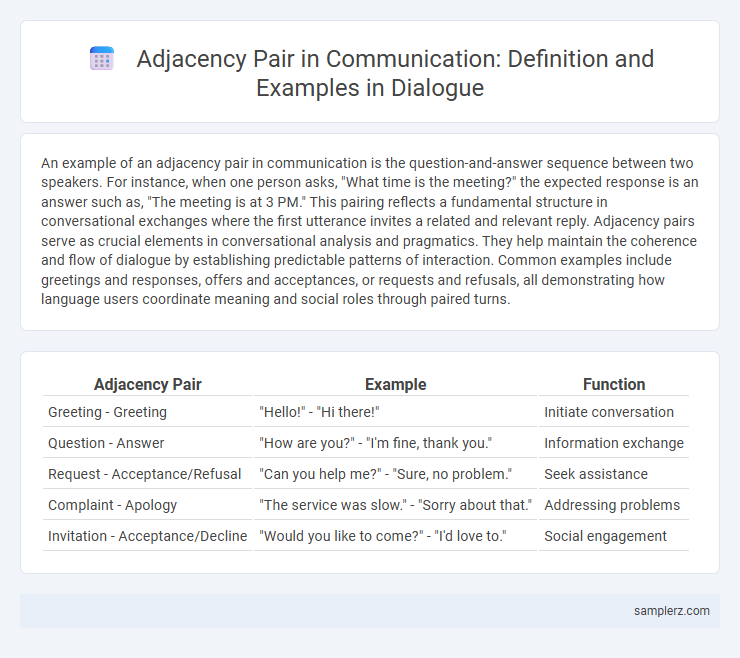An example of an adjacency pair in communication is the question-and-answer sequence between two speakers. For instance, when one person asks, "What time is the meeting?" the expected response is an answer such as, "The meeting is at 3 PM." This pairing reflects a fundamental structure in conversational exchanges where the first utterance invites a related and relevant reply. Adjacency pairs serve as crucial elements in conversational analysis and pragmatics. They help maintain the coherence and flow of dialogue by establishing predictable patterns of interaction. Common examples include greetings and responses, offers and acceptances, or requests and refusals, all demonstrating how language users coordinate meaning and social roles through paired turns.
Table of Comparison
| Adjacency Pair | Example | Function |
|---|---|---|
| Greeting - Greeting | "Hello!" - "Hi there!" | Initiate conversation |
| Question - Answer | "How are you?" - "I'm fine, thank you." | Information exchange |
| Request - Acceptance/Refusal | "Can you help me?" - "Sure, no problem." | Seek assistance |
| Complaint - Apology | "The service was slow." - "Sorry about that." | Addressing problems |
| Invitation - Acceptance/Decline | "Would you like to come?" - "I'd love to." | Social engagement |
Defining Adjacency Pairs in Communication
Adjacency pairs in communication are structured sequences of two related utterances by different speakers, where the first utterance prompts a predictable response, such as a question followed by an answer or a greeting followed by a return greeting. These pairs serve as fundamental units of conversation that facilitate turn-taking and coherence in dialogue. Common examples include "How are you?" followed by "I'm fine, thank you," illustrating the expected response structure essential for mutual understanding.
Common Types of Adjacency Pairs
Common types of adjacency pairs in communication include greeting-greeting responses, question-answer exchanges, and offer-acceptance or refusal sequences. These pairs structure conversations by linking an initial utterance with an expected, relevant reply, facilitating coherent dialogue flow. Examples include "How are you?" followed by "I'm fine, thank you," and "Can you help me?" answered with "Sure, what do you need?
Greeting and Response Examples
Greeting and response examples in dialogue often include adjacency pairs such as "Hello" followed by "Hi" or "Good morning" paired with "Good morning, how are you?" These exchanges establish social connection and set the tone for conversation, reflecting politeness and mutual recognition. Common greeting adjacency pairs are essential in both face-to-face and digital communication contexts, facilitating smooth interaction.
Question and Answer Adjacency Pairs
Question and Answer adjacency pairs are fundamental in communication, exemplified by a speaker asking, "What time is the meeting?" followed by the response, "The meeting starts at 3 PM." This structure enhances clarity and facilitates smooth information exchange, ensuring both participants understand and acknowledge the conveyed message accurately. Effective use of question-answer pairs improves conversational coherence and supports mutual understanding in dialogues.
Offer and Acceptance Dialogues
In communication, an example of an adjacency pair involving offer and acceptance occurs when one speaker proposes a service or item, such as "Would you like some coffee?" followed by the respondent's acceptance, "Yes, please." This exchange exemplifies how offers invite responses that confirm agreement or consent, facilitating smooth and cooperative interactions. Understanding these pairs is essential for analyzing conversational structures and social etiquette.
Invitation and Response Samples
An example of adjacency pair in communication is the invitation "Would you like to join us for dinner?" followed by the response "Yes, I'd love to." Invitations typically initiate a social action, while responses confirm acceptance or decline, creating a structured exchange. This pattern ensures clarity and mutual understanding in conversational interactions.
Complaint and Apology Sequences
In communication, an adjacency pair consisting of a complaint and an apology typically involves one speaker expressing dissatisfaction, such as "The product arrived late," followed by the second speaker responding with an apology like "I'm sorry for the delay." This sequence establishes a clear cause-and-effect relationship that facilitates repair and understanding in conversations. Effective use of complaint and apology adjacency pairs enhances interpersonal communication and conflict resolution.
Request and Compliance Interactions
In communication, an example of adjacency pair involving request and compliance includes a speaker asking, "Could you pass the salt?" followed by the listener's response, "Sure, here you go." This structure exemplifies the turn-taking system where the first utterance functions as a request and the second as compliance, ensuring cooperative interaction. Adjacency pairs like these play a crucial role in maintaining clarity and social harmony during conversations.
Assessment and Agreement Pairs
Assessment and agreement pairs in dialogue often involve expressions like compliments followed by acceptance, such as "You did a great job!" paired with "Thank you, I appreciate it." These adjacency pairs facilitate smooth conversational flow by confirming positive evaluations and reinforcing mutual understanding. Effective use of these pairs enhances rapport and clarity in interpersonal communication.
Closing and Farewell Exchanges
Closing and farewell exchanges in communication often include adjacency pairs such as "Goodbye" followed by "See you later," serving to signal the end of an interaction. These pairs function to confirm mutual acknowledgment of the conversation's conclusion and establish politeness. Examples like "Take care" and "You too" demonstrate how participants collaboratively manage conversational closure.

example of adjacency pair in dialogue Infographic
 samplerz.com
samplerz.com